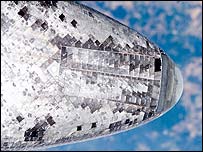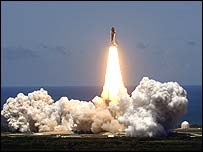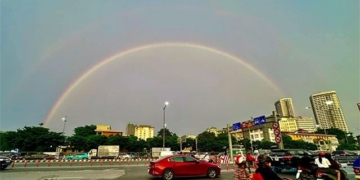 |
| Inspection scan shows no damage to the space shuttle (Photo: BBC) |
The orbiter and its six-member crew began their landing process an hour after firing the braking rockets.
Discovery was cleared to return over the weekend after inspections revealed no signs of damage.
The shuttle landed at the Kennedy Space Center in Florida at 1:14 PM GMT.
The crew was awakened early Monday morning to begin preparations for their return to Earth, a phase often regarded as the most hazardous during a shuttle mission.
NASA officials believe the clear success of this mission marks a definitive conclusion to ongoing doubts about the safety of the shuttle program.
The flight of Discovery was only the second mission since the Columbia disaster in 2003, which resulted in the loss of the entire crew and the vehicle’s debris falling to the ground.
Threat of Rain
Upon landing, the shuttle had one less crew member than it did at launch, leaving German astronaut Thomas Reiter aboard the International Space Station to work for six months.
Flight control had to wait until the last moment to confirm that the weather was suitable for landing.
|
Discovery Shuttle Flight
– Flight STS-121 is the 32nd mission of Discovery and the 18th orbital flight to the International Space Station.
– Landing: 1:14 PM GMT
– Location: Kennedy Space Center
– Crew: Lindsey, Kelly, Fossum, Nowak, Wilson, Sellers
|
There were some concerns about a band of rain clouds in northern Florida that were forecasted to move toward the landing area.
Once cleared, shuttle commander Steven Lindsey and pilot Mark Kelly initiated the spacecraft’s descent from orbit.
Back on Track
Before landing, Lindsey remarked that the clear flight of Discovery would dispel any lingering doubts about the safety of the shuttle program.
“I hope what we’ve accomplished will close the book on returning to the test flights of this program after the Columbia accident,” he told ABC News in the United States.
“Personally, I believe we are back on the right track.”
Investigation teams determined that the Columbia disaster was caused by a piece of foam insulation breaking off the shuttle’s external fuel tank during launch, striking the wing and damaging the thermal protection system essential for re-entry.
Thermal protection scans of Discovery were conducted using the same laser and camera system that was employed to check for potential damage from debris during the earlier ascent of the flight.
This system also assessed the impact of micrometeoroids that could harm the shuttle during its journey.
This mission included three spacewalks and performed critical repairs to resume construction work on the International Space Station.
———————————————————————-
Astronauts on Discovery Complete Second Spacewalk
Discovery: Preparing to Step Out into Space



















































